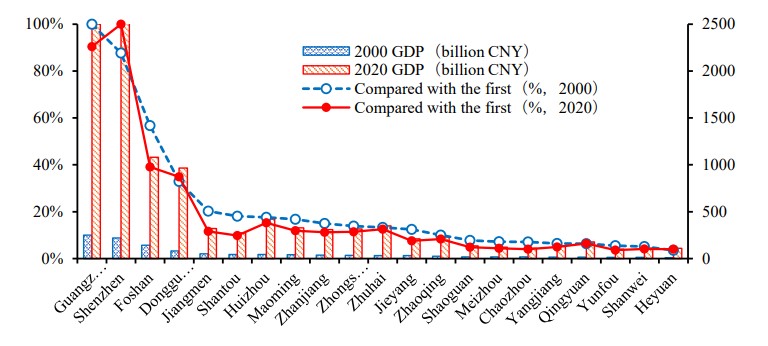A New Supply Chain and Sustainable Development Mechanism of Guangdong under the Framework of RECP
Main Article Content
บทคัดย่อ
This article takes the theory of regional economic development as the research perspective and uses relevant economic indicators to analyze the differential performance of the coordinated development of the regional economy in Guangdong Province under the RCEP framework from two aspects, including static and dynamic aspects. Subsequently, the regional economic development in Guangdong Province is analysed, in terms of its industrial layout of the coordinated economic development, logistics and transportation network.
Secondly, based on the regional economic theory, this paper further analyses the crux of the uncoordinated regional development of Guangdong Province, and finally put forward the countermeasures and suggestions to promote the coordinated development of Guangdong Province. This paper is to strengthen and consolidate the interconnection of regional supply chains, promote institutional opening, improve the level of trade and investment facilitation, form a regional economic layout with complementary advantages and high-quality development, which is the core hub of RCEP, together with accelerating the high-quality development of East Asian economies, and promoting China's domestic and international with construction of a new dual-cycle development pattern.
Article Details

อนุญาตภายใต้เงื่อนไข Creative Commons Attribution-NonCommercial-NoDerivatives 4.0 International License.
บทความนี้ได้รับการเผยแพร่ภายใต้สัญญาอนุญาต Creative Commons Attribution-NonCommercial-NoDerivatives 4.0 International (CC BY-NC-ND 4.0) ซึ่งอนุญาตให้ผู้อื่นสามารถแชร์บทความได้โดยให้เครดิตผู้เขียนและห้ามนำไปใช้เพื่อการค้าหรือดัดแปลง หากต้องการใช้งานซ้ำในลักษณะอื่น ๆ หรือการเผยแพร่ซ้ำ จำเป็นต้องได้รับอนุญาตจากวารสารเอกสารอ้างอิง
Azizova, G., KuliK, A., Kogteva, A., Stryabkov, A., & Mikayilzade, G. (2019). The Identification of Poles of Competitiveness of the Economy through Inter-regional Cooperation. 37th International Scientific Conference on Economic and Social Development - Socio Economic Problems of Sustainable Development (ESD 2019), 413-419.
Brais, S. E., Emilio, F., Gonzalo, M. M., & David, S, O. (2019). Operational principles of circular economy for sustainable development: linking theory and practice. Journal of Cleaner Production, 214, 952-961.
Burenmende, B. (2015). Basic Paths for Coordinated Development of Chinas Regional Economy and Construction of Long-term Mechanism. 2015 International Conference on Education Technology and Economic Management. Atlantis Press.
Deng, F. M., Liu, C. M., & Liang, X. D. (2017). Measurement of regional agricultural sustainable development system based on dissipative structure theory: a case study in sichuan province, china. Sustainability, 9(11), 2047.
Guo, Q., & Xu, Q. Z. (2016). Mechanism Study of the Construction of the Coordinated Development Patterns of Regional Economy and Technological Finance. Journal of Residuals Science & Technology, 13(3).
Gong, Q. X., Min, C., Zhao, X. L., & Ji, Z. G. (2019). Sustainable urban development system measurement based on dissipative structure theory, the grey entropy method and coupling theory: a case study in chengdu, china. Sustainability, 11(1), 1-19.
Lee, S. E. (2016). The socio-cultural impact of growth-pole theory (GPT) tourism development. Anatolia, 27(2), 268-270.
Li, C., & Sun, Y. (2017). Analysis on Cultural Industry Development Strategy of Jingchu Cultural Circle Based on Growth Pole Theory. Third Annual International Conference on Management (ICMESD 2017).
Li, S. P., Gong, Q. X., & Yang, S. L. (2019). A sustainable, regional agricultural development measurement system based on dissipative structure theory and the entropy weight method: a case study in chengdu, china. Sustainability, 11(19), 1-15.
Li, S. R. (2018). A study of coordinated development mechanism of regional economy. Journal of Heihe University, 9(06), 84-85.
Ng, B. K., Kanagasundram, T., Wong, C. Y., & Chandran, V. G. R. (2016). Innovation for inclusive development in southeast asia: the roles of regional coordination mechanisms. The Pacific Review, 29(4), 573-602.
Rauhut, D., & Humer, A. (2020). Eu cohesion policy and spatial economic growth: trajectories in economic thought. European Planning Studies, 28(11), 2116-2133.
She, S. F. (2015). Industrial diffusion mechanism and shandong provincial policy on coordinated regional economy development. Journal of Shandong University of Finance and Economics, 27(04), 65-70.
Wei, Y. N. (2018). Analysis on the Coordinated Development Mechanism of Regional Economy. 2018 International Conference on Economics, Finance, Business and Development (ICEFBD 2018). Francis Academic Press.
Xiang, C., & Song, X. D. (2017). Research on the optimization of Chinese counterpart assistance policy based on the perspective of growth pole theory. Second International Conference on Economic and Business Management (FEBM 2017). Atlantis Press.
XU, Q. (2018). Analysis of the Coordinated Development Mechanism of Regional Economy. 2018 5th International Conference on Business, Economics and Management(BUSEM 2018). Francis Academic Press.
Zhang, H., & Xiao, Y. (2019). Planning island sustainable development policy based on the theory of ecosystem services: a case study of zhoushan archipelago, east china. Island Studies Journal, 15, 237-252.
Zhang, T., Ou, X. J., Li,T., Li, X. Z., & Wang,Y. (2018). An analysis of the coordinated development of regional economy and it's dynamic mechanism in jiangsu province. Territory & Natural Resources Study, 2018(02), 84-89.
Zhang, X. L. (2013). Regional Economic Convergence Mechanisms in the Yangtze River Delta. Social Sciences in China,34(03):140-158


